You know that moment when you're passing by an Andok's and that unmistakable aroma of lechon manok stops you in your tracks? That was my weakness for years, especially during those hectic weekday nights when cooking felt like climbing Mt. Pinatubo!
But everything changed when my Tita shared this lechon manok recipe with me. Let me tell you, this homemade lechon manok is a total game-changer. After countless attempts (and yes, a few charred chickens that we don't talk about 😅), I've perfected this recipe that rivals our favorite Andok's version.
The best part? While your chicken is marinating, you can actually do your laundry, catch up on K-dramas, or scroll through TikTok.
Once you nail this recipe, your family will stop asking "Andok's tayo?" and start begging for your homemade lechon manok instead. The skin is seriously crispy, the meat is juicier than your favorite chismis, and that garlicky-citrusy marinade? It's about to make your kitchen smell better than any street-side rotisserie!
Jump to:
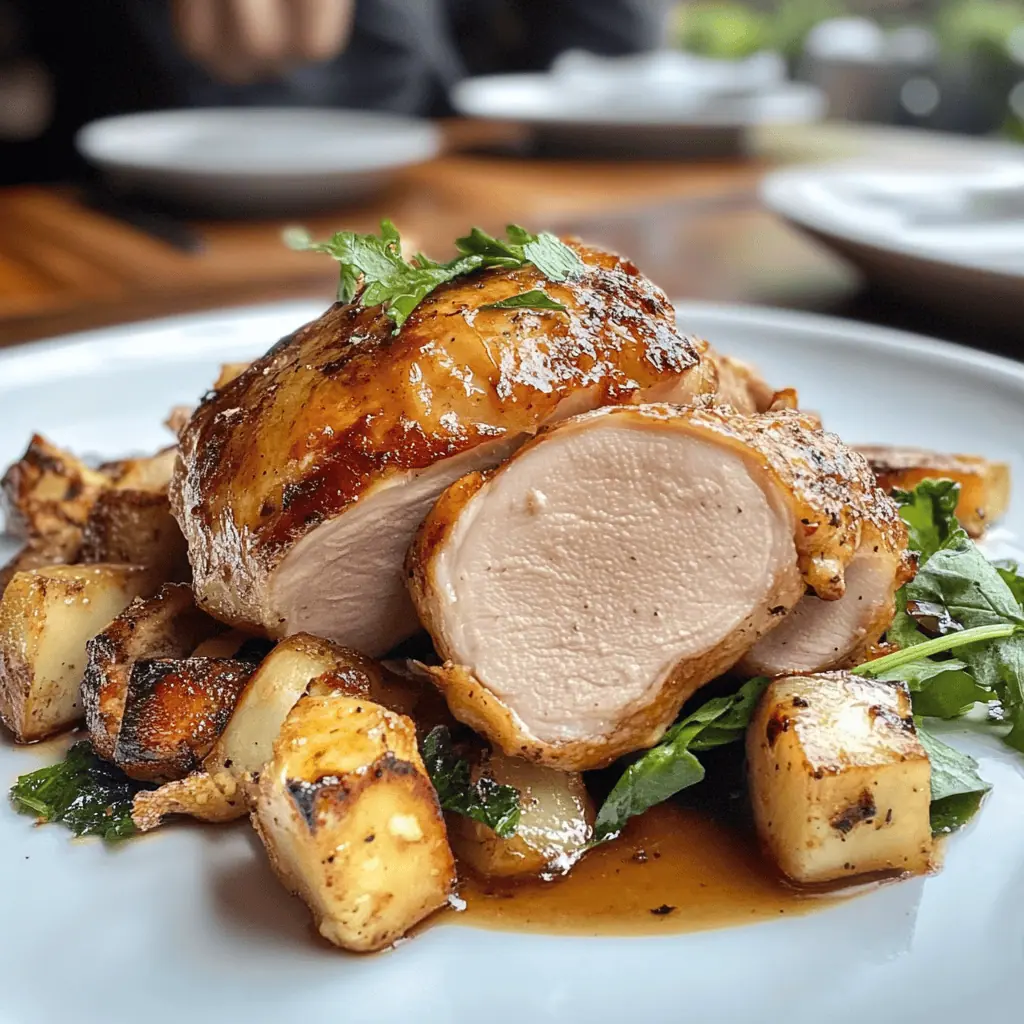
Why You'll Love This Recipe
- Perfect Crispy Skin - Our tested technique guarantees that coveted golden-brown, crispy exterior (Balat na malutong)
- Ultra-Juicy Meat - Special marination process ensures the meat stays moist (Malaman at malambot)
- Authentic Flavor - Traditional Filipino seasonings create that classic street-corner lechon taste
- Better Than Takeout - Save money while achieving restaurant-quality results
- Make-Ahead Friendly - Great for meal prep and family gatherings
Ingredients
The magic of this Lechon Manok lies in its carefully selected ingredients that create an authentic Filipino flavor profile. Calamansi juice provides the signature tangy brightness that cuts through the richness of the chicken, while fish sauce and soy sauce deliver deep umami notes essential to Filipino cuisine.
Brown sugar balances the acidity and promotes beautiful caramelization on the skin. The aromatic combination of garlic, shallots, and lemongrass, staples in Southeast Asian cooking, infuses the meat with complex layers of flavor that develop during marination.
These ingredients work harmoniously to create that unmistakable sweet-savory-tangy profile that makes Filipino-style roasted chicken so irresistible and distinctive from other roasted chicken recipes around the world.
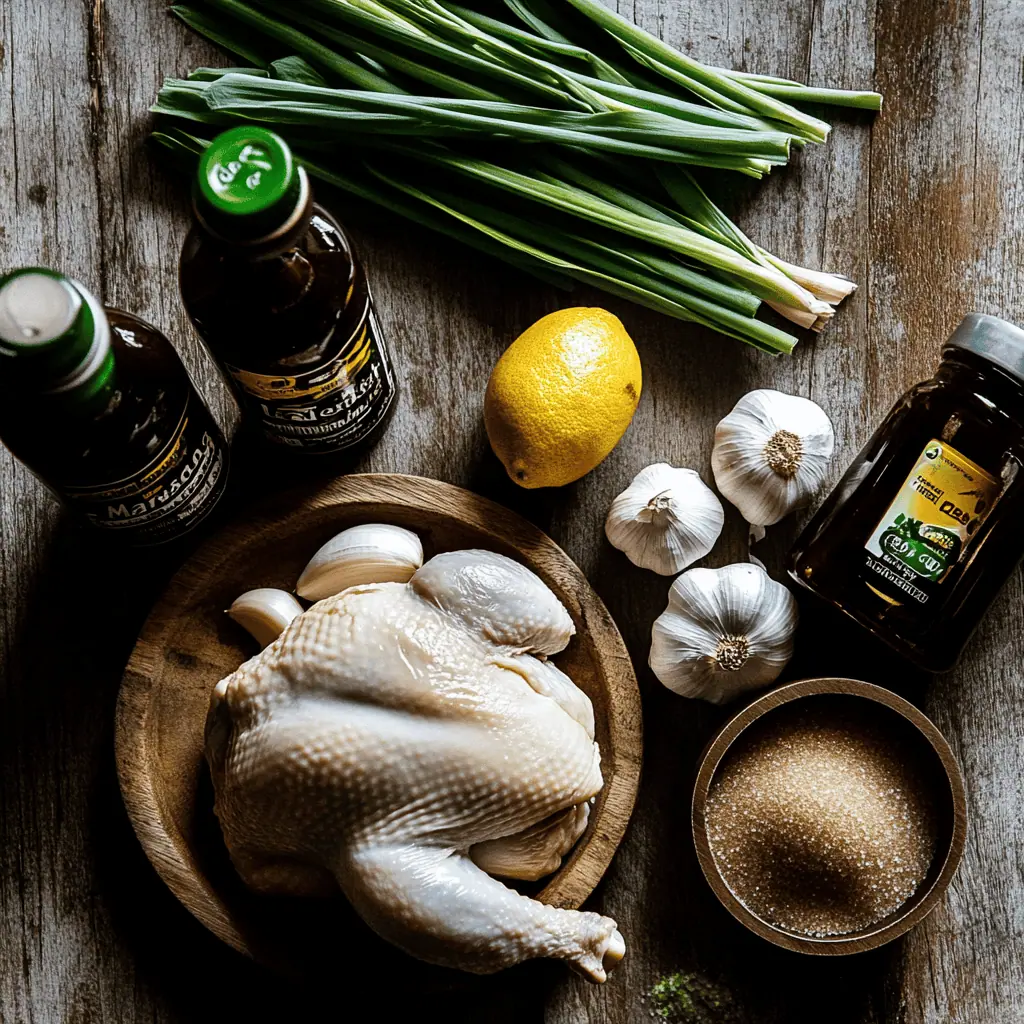
For the Chicken:
- 1 whole chicken (4-5 pounds), cleaned
- Salt and pepper to taste
For the Signature Marinade:
- 1 cup calamansi juice (substitute: ½ cup lime juice + ½ cup orange juice)
- ¼ cup fish sauce (patis)
- ¼ cup soy sauce
- 3 tablespoons brown sugar
- 1 whole head garlic, peeled and minced
- 4 shallots, peeled and minced
- 1 stalk lemongrass
- 2 kaffir lime leaves (optional, for enhanced aroma)
Equipment
- Turbo Broiler: The star of this recipe, providing even heat circulation for perfect browning (A conventional oven with a roasting rack works too, but the turbo broiler creates that authentic texture)
- Large Mixing Bowl: For preparing and holding the marinade
- Sharp Kitchen Knife: To make small cuts in the chicken skin for better marinade penetration
- Meat Thermometer: Ensures your chicken reaches the safe internal temperature of 74°C/165°F
- Basting Brush: For applying marinade during cooking to enhance flavor and browning
- Paper Towels: Essential for drying the chicken thoroughly before cooking
- Airtight Container: For storing the chicken while marinating
- Cutting Board: Preferably with a juice groove to catch drippings when preparing and carving
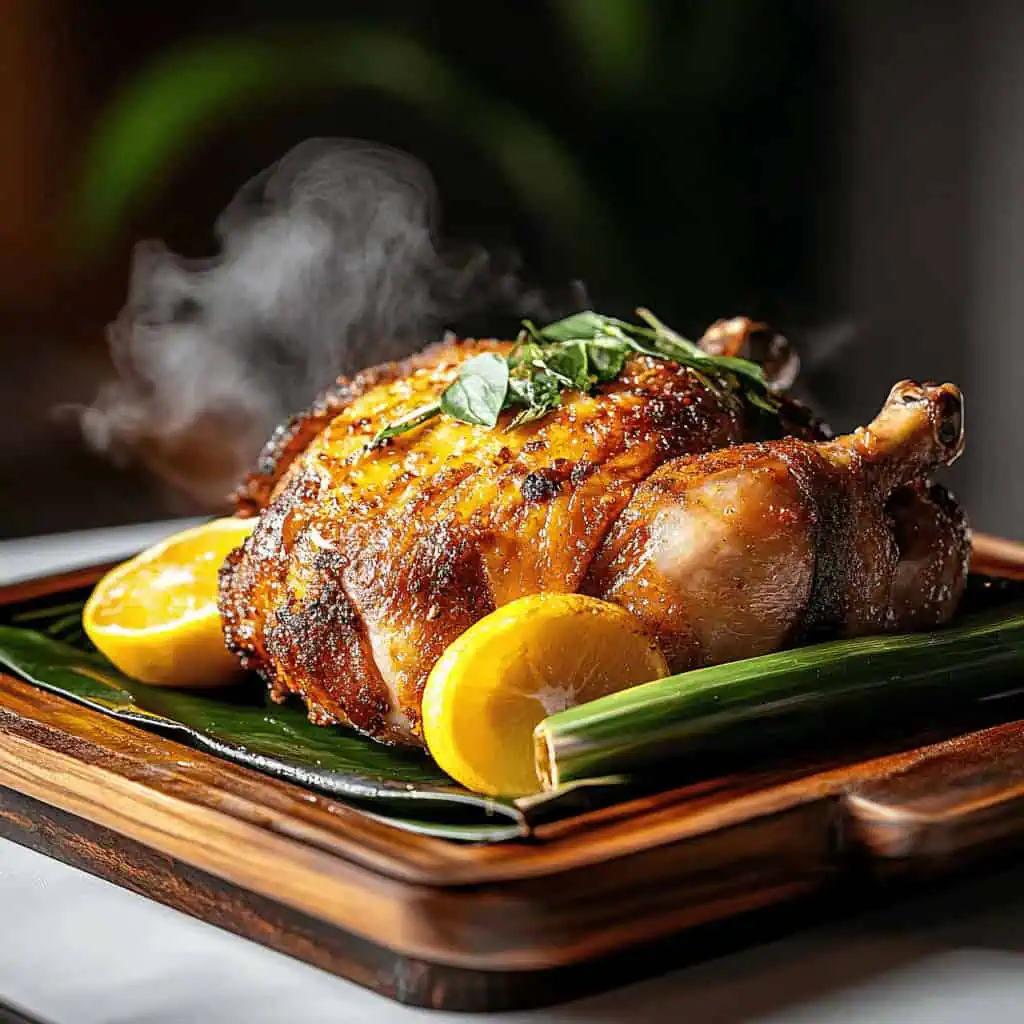
How To Make
- Prepare the Chicken: Remove all giblets and excess fat. Rinse thoroughly under cold running water and pat completely dry using paper towels. This crucial step ensures crispy skin.
- Score the Skin: Make small cuts across the chicken's skin using a sharp knife. This helps the marinade penetrate deeper into the meat. Season the entire chicken, including the cavity, with salt and pepper.
- Create the Marinade: In a large mixing bowl, combine calamansi juice, fish sauce, soy sauce, and brown sugar. Stir continuously until the sugar completely dissolves. Add minced garlic and shallots, mixing thoroughly.
- Marinate the Chicken: Place your seasoned chicken in the marinade, ensuring it's well-coated. Massage the marinade thoroughly into the skin and cavity. Cover and refrigerate for 4-8 hours at 4°C/39°F, turning the chicken every 2-3 hours for even flavor distribution.
- Prepare for Cooking: Thirty minutes before cooking, remove the chicken from the refrigerator to reach room temperature. Prepare the lemongrass by bruising it with the back of a knife, then cut it into 3-inch pieces. Stuff these pieces into the chicken's cavity.
- Initial Cooking Phase: Preheat your turbo broiler to 180°C/350°F. Place the chicken breast-side down and cook for 20-30 minutes, basting with the reduced marinade every 10 minutes.
- Flip and Continue: Carefully flip the chicken breast-side up. Continue cooking at 180°C/350°F for another 20-30 minutes, maintaining your basting schedule.
- Final Browning: Increase the temperature to 215°C/420°F. Cook for a final 10-15 minutes until the skin turns beautifully golden brown and crispy.
- Check for Doneness: The chicken is properly cooked when a meat thermometer inserted into the thickest part reads 74°C/165°F. The juices should run clear when you tilt the chicken, and the joints should move easily.
- Rest Before Serving: Let your lechon manok rest for 15-20 minutes before cutting. This allows the juices to redistribute throughout the meat, ensuring every bite is moist and flavorful.

Tips from Lola's Kitchen
- For Extra Crispy Skin: Pat the chicken completely dry before seasoning
- Even Cooking: Never skip the room temperature rest before cooking
- Enhanced Flavor Penetration: Create small slits in the chicken skin
- Flavor Boost: Save the chicken drippings for the most flavorful rice
- Ultimate Juiciness: Always let the chicken rest before carving
- Flavor Development: For the most intense flavor, marinate overnight
Substitutions
- Calamansi Juice: Equal parts lime juice and orange juice provide a similar tangy-sweet profile
- Fish Sauce: Light soy sauce mixed with a small amount of anchovy paste
- Fresh Garlic: 2 tablespoons of garlic powder (though fresh is strongly preferred)
- Lemongrass: Combination of lemon zest and a small piece of ginger
- Shallots: Red onion, finely minced (use about ¾ the amount)
- Brown Sugar: Palm sugar, coconut sugar, or honey (slightly reduce quantity)
- Turbo Broiler: Conventional oven with a roasting rack set at 350°F (results will vary slightly)
Troubleshooting
Skin Not Crispy Enough?
- Ensure the chicken is completely dry before cooking
- Brush lightly with oil during the final cooking stage
- Increase temperature by 10-15°F for the last 5 minutes
- Use the broiler function for 2-3 minutes at the end (watch carefully!)
Meat Too Dry?
- Verify your cooking time—overcooked chicken quickly dries out
- Check internal temperature earlier in the cooking process
- Extend the marinating time to at least 8 hours
- Ensure proper basting throughout cooking
Uneven Cooking?
- Allow chicken to fully reach room temperature before cooking
- Rotate the chicken during cooking if your turbo broiler has hot spots
- Check that all heating elements in your appliance are functioning properly
- Consider trussing the chicken for more even heat distribution
Marinade Not Flavorful Enough?
- Increase marinating time to overnight
- Slightly increase salt or soy sauce content
- Add 1-2 additional tablespoons of minced garlic
- Reduce 2 tablespoons of marinade in a small pan until syrupy, then use for final basting
Storage & Reheating
Refrigeration
- Store leftovers in an airtight container for up to 3 days
- For best results, separate the meat from bones before storing
Freezing
- Wrap portions tightly in plastic wrap then aluminum foil
- Freeze for up to 2 months
- Label with date and contents
- Thaw completely in refrigerator before reheating
Reheating Methods
For Crispy Skin:
- Oven: Preheat to 350°F and heat for 15-20 minutes until internal temperature reaches 165°F
- Air Fryer: 350°F for 5-7 minutes for smaller pieces
For Quick Reheating:
- Microwave: Use 70% power and cover with a damp paper towel to prevent drying
- Add a tablespoon of chicken broth before reheating for extra moisture
To Revive Crispy Skin After Refrigeration:
- Place under broiler for 2-3 minutes after initial reheating
- Brush lightly with oil before reheating for better crisping
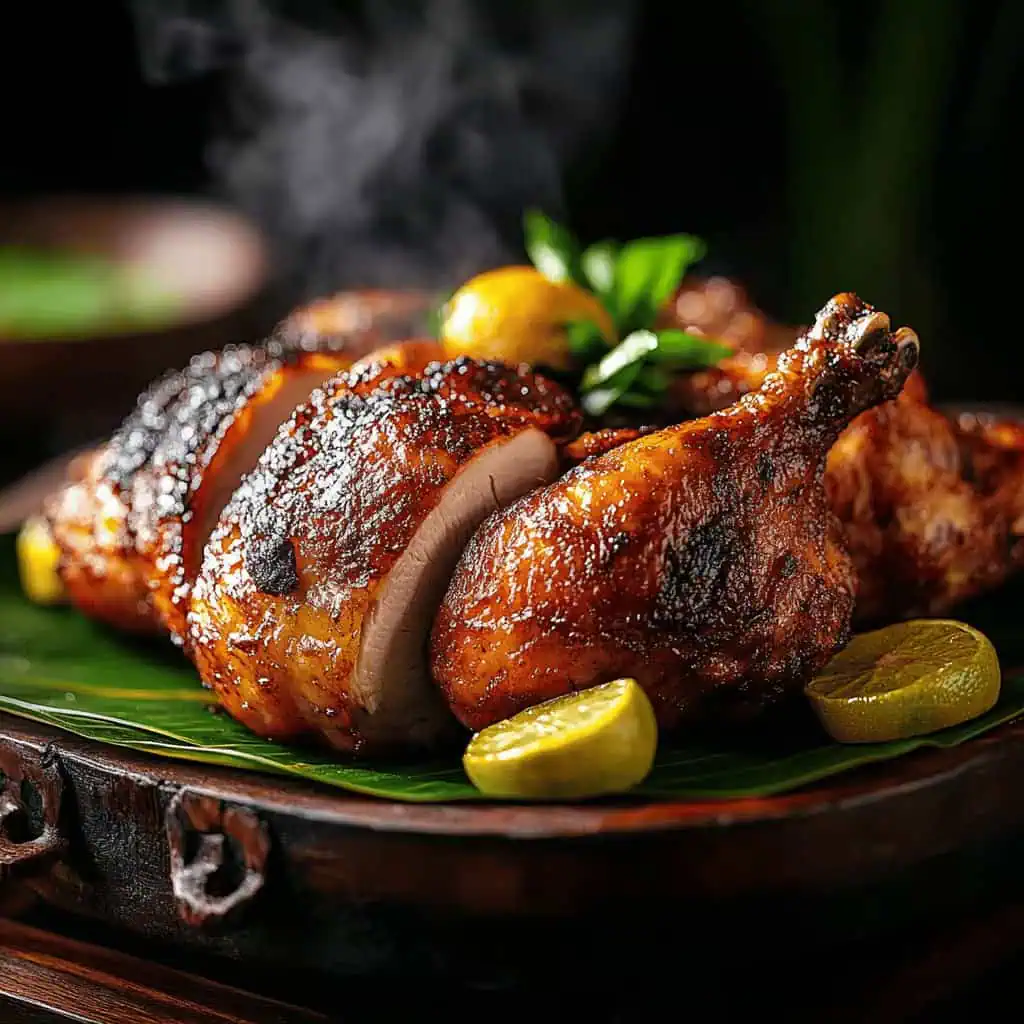
FAQ
Can I prepare this recipe without a turbo broiler?
Yes! While a turbo broiler creates the most authentic results, you can use a conventional oven with a roasting rack. Cook at 350°F following the same timing guidelines, but you may need to increase the final temperature to 425°F for proper skin crisping.
How long should I really marinate the chicken?
For optimal flavor, 8 hours is ideal, but you can marinate for as little as 4 hours if pressed for time. For the most intense flavor development, marinate overnight (up to 24 hours).
Is it necessary to baste the chicken while cooking?
Basting is highly recommended as it adds flavor and helps achieve that beautiful golden color. If you're short on time, at minimum baste once halfway through cooking and once near the end.
Can I use chicken parts instead of a whole chicken?
Absolutely! Chicken quarters or leg portions work wonderfully with this recipe. Reduce cooking time to about 35-45 minutes total, maintaining the same temperature progressions.
What's the best way to ensure the chicken cooks evenly?
Allow the chicken to come to room temperature before cooking, truss it if possible, and rotate it during cooking. Using a meat thermometer is essential for perfect results.
How can I make this healthier?
Use skinless chicken pieces, reduce the brown sugar by half, and limit the basting to once or twice during cooking. The flavor will still be delicious with less fat and sugar.
Can I make the marinade in advance?
Yes! The marinade can be prepared up to 3 days ahead and stored in the refrigerator. This is an excellent time-saving strategy.
Related
Looking for other recipes like this? Try these:
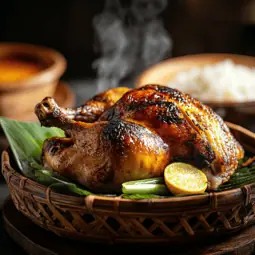
Authentic Filipino Lechon Manok (Turbo Broiler Roasted Chicken)
Ingredients
For the Chicken:
- 1 whole chicken 4-5 pounds, cleaned
- Salt and pepper to taste
For the Signature Marinade:
- 1 cup calamansi juice substitute: ½ cup lime juice + ½ cup orange juice
- ¼ cup fish sauce patis
- ¼ cup soy sauce
- 3 tablespoons brown sugar
- 1 whole head garlic peeled and minced
- 4 shallots peeled and minced
- 1 stalk lemongrass
- 2 kaffir lime leaves optional, for enhanced aroma
Instructions
- Start by removing all the giblets and excess fat from your chicken (Alisin ang laman-loob at sobrang taba ng manok). Rinse the chicken thoroughly under cold running water and pat it completely dry using paper towels. This step is crucial for achieving crispy skin (Para maging malutong ang balat).
- Make small cuts across the chicken's skin using a sharp knife (Gawin ang maliliit na hiwa sa balat). This will help the marinade penetrate deeper into the meat. Season the entire chicken, including the cavity, with salt and pepper (Timplahan ng asin at paminta ang loob at labas ng manok).
- In a large mixing bowl, combine calamansi juice, fish sauce (patis), soy sauce (toyo), and brown sugar (asukal na pula). Stir continuously until the sugar completely dissolves. Add your minced garlic (tinadtad na bawang) and shallots (sibuyas tagalog) to the marinade mixture. Mix everything thoroughly.
- Place your seasoned chicken in the marinade, making sure it's well-coated (Ibabad ang manok sa marinade). Massage the marinade thoroughly into the skin and cavity. Cover your marinating chicken and place it in the refrigerator. Allow it to marinate for 4-8 hours at 4°C/39°F, turning the chicken every 2-3 hours to ensure even flavor distribution (Baliktarin ang manok kada 2-3 oras para pantay ang pagkakalambot).
- Thirty minutes before cooking, remove the chicken from the refrigerator and let it reach room temperature (Ilabas ang manok sa ref 30 minuto bago lutuin). During this time, prepare your lemongrass by bruising it with the back of a knife, then cut it into 3-inch pieces. Stuff these pieces into the chicken's cavity (Ilagay ang tanglad sa loob ng manok).
- Preheat your turbo broiler to 180°C/350°F (Initin ang turbo sa 180°C). Place the chicken breast-side down and cook for 20-30 minutes, basting with the reduced marinade every 10 minutes (Pahiran ng marinade kada 10 minuto).
- After the initial cooking period, carefully flip the chicken so it's breast-side up. Continue cooking at 180°C/350°F for another 20-30 minutes, maintaining your basting schedule.
- For the final stage of cooking, increase the temperature to 215°C/420°F (Pataasin ang init sa 215°C). Cook for a final 10-15 minutes until the skin turns a beautiful golden brown and becomes crispy (Lutuin hanggang maging golden brown at malutong ang balat).
- The chicken is done when a meat thermometer inserted into the thickest part reads 74°C/165°F (Luto na ang manok kapag umabot sa 74°C ang temperatura sa loob). The juices should run clear when you tilt the chicken, and the joints should move easily.
- Let your lechon manok rest for 15-20 minutes before cutting. This resting period allows the juices to redistribute throughout the meat, ensuring every bite is moist and flavorful (Para masiguradong makatas ang karne).
- Serve your lechon manok hot with toyomansi sauce (toyo at kalamansi) on the side. Traditional accompaniments include steamed rice (kanin), cucumber slices (pipino), and atchara (pickled papaya). Store any leftovers in an airtight container in the refrigerator for up to three days, or freeze for up to two months. When reheating, warm in a preheated oven at 177°C/350°F for 15-20 minutes to maintain the crispy skin.
Tips from Lola's Kitchen
- Pat the chicken completely dry before seasoning for crispier skin
- Don't skip the room temperature rest - it ensures even cooking
- Create small slits in the chicken skin to help marinade penetrate
- Save the chicken drippings for the most flavorful rice
- Let the chicken rest for 15-20 minutes before cutting for juicier meat
Nutrition
The Story Behind Lechon Manok (Turbo Broiler Roasted Chicken)
Lechon Manok, the Filipino-style roasted chicken, represents the perfect marriage of traditional Filipino flavors and modern convenience. What makes this dish particularly fascinating is how it democratized the "lechon experience"—bringing the festive taste of roasted meat to everyday Filipino meals through the innovation of turbo broilers and rotisserie cooking. While its more famous cousin, Lechon Baboy (roasted pig), rules grand celebrations, Lechon Manok became the working class hero, making perfectly roasted chicken accessible from street corners to home kitchens.
The brilliance of Lechon Manok lies in its marinade and cooking method. The chicken is bathed in a signature blend of lemongrass, garlic, soy sauce, and calamansi, creating that distinctly Filipino taste that sets it apart from other roasted chickens worldwide. The introduction of the turbo broiler in Filipino households was revolutionary—suddenly, families could recreate the same smoky, juicy flavors of market-bought lechon manok at home. The constant rotation while cooking ensures that magical combination of crispy, golden-brown skin and tender, flavorful meat that drips with natural juices.
Today, while lechon manok stalls dot every city corner offering convenient takeaway meals, the home-cooked version holds its own special place in Filipino kitchens. Whether cooked in a turbo broiler, conventional oven, or rotisserie, it remains a testament to Filipino ingenuity—transforming a simple chicken into a dish that's special enough for Sunday family lunches yet practical enough for everyday meals. The accompanying lechon sauce or spiced vinegar dip adds that final touch of Filipino flavor that makes this dish irresistibly authentic.
Remember: Perfect lechon manok isn't just about the cooking time—it's about that patience in marinating, the right blend of aromatics, and achieving that golden-brown skin that crackles when you cut into it.










Comments
No Comments